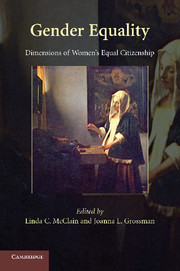Book contents
- Frontmatter
- Contents
- Contributors
- Acknowledgments
- Gender Equality
- Introduction
- PART I CONSTITUTIONAL CITIZENSHIP AND GENDER
- 1 Gender at the Margins of Contemporary Constitutional Citizenship
- 2 Becoming a Citizen: Marriage, Immigration, and Assimilation
- 3 Women's Civic Inclusion and the Bill of Rights
- 4 Must Feminists Identify as Secular Citizens? Lessons From Ontario
- 5 Feminist Fundamentalism and Constitutional Citizenship
- PART II POLITICAL CITIZENSHIP AND GENDER
- PART III SOCIAL CITIZENSHIP AND GENDER
- PART IV SEXUAL AND REPRODUCTIVE CITIZENSHIP
- PART V GLOBAL CITIZENSHIP AND GENDER
- Suggested Readings
- Index
- References
1 - Gender at the Margins of Contemporary Constitutional Citizenship
Published online by Cambridge University Press: 05 August 2012
- Frontmatter
- Contents
- Contributors
- Acknowledgments
- Gender Equality
- Introduction
- PART I CONSTITUTIONAL CITIZENSHIP AND GENDER
- 1 Gender at the Margins of Contemporary Constitutional Citizenship
- 2 Becoming a Citizen: Marriage, Immigration, and Assimilation
- 3 Women's Civic Inclusion and the Bill of Rights
- 4 Must Feminists Identify as Secular Citizens? Lessons From Ontario
- 5 Feminist Fundamentalism and Constitutional Citizenship
- PART II POLITICAL CITIZENSHIP AND GENDER
- PART III SOCIAL CITIZENSHIP AND GENDER
- PART IV SEXUAL AND REPRODUCTIVE CITIZENSHIP
- PART V GLOBAL CITIZENSHIP AND GENDER
- Suggested Readings
- Index
- References
Summary
One revealing fact about the subject of this chapter is that if we wish to focus on recent United States Supreme Court decisions that specifically address the relationship of gender to constitutional citizenship, there are very few cases to consider. If we leave aside related but distinguishable issues involving abortion rights and sexual orientation, the most discussed constitutional cases involving discriminatory treatment of women in the past decade are probably United States v. Virginia and United States v. Morrison, followed by a less famous but in some respects more pertinent case, Nguyen v. INS. Feminist legal scholars have also been struck by the late Chief Justice William Rehnquist's surprisingly strong defense of the Family and Medical Leave Act of 1993 (FMLA) against an Eleventh Amendment challenge in Nevada Department of Human Resources v. Hibbs.
In all these cases, questions of gender and constitutional citizenship were, in important respects, marginal issues, though in different ways in each case. In United States v. Virginia and Nguyen, issues of equal constitutional citizenship for women were explicitly at the center of the matters the Justices considered. But the contexts of the cases – a woman seeking admission to an all-male public military college, a man claiming citizenship who was born abroad to an unmarried citizen father and a noncitizen mother – were ones well outside the experiences of most Americans.
- Type
- Chapter
- Information
- Gender EqualityDimensions of Women's Equal Citizenship, pp. 23 - 38Publisher: Cambridge University PressPrint publication year: 2009
References
- 1
- Cited by



